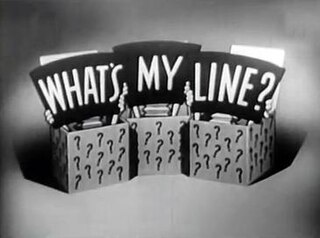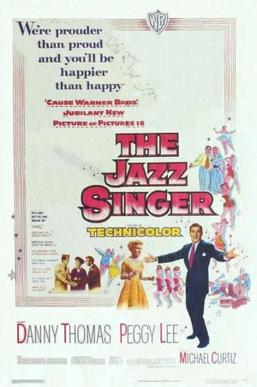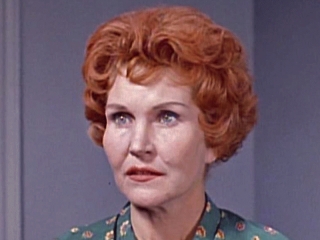Related Research Articles

The Jazz Singer is a 1927 American part-talkie musical drama film directed by Alan Crosland and produced by Warner Bros. Pictures. It is the first feature-length motion picture with both synchronized recorded music and lip-synchronous singing and speech. Its release heralded the commercial ascendance of sound films and effectively marked the end of the silent film era with the Vitaphone sound-on-disc system, featuring six songs performed by Al Jolson. Based on the 1925 play of the same title by Samson Raphaelson, the plot was adapted from his short story "The Day of Atonement".

Videotape is magnetic tape used for storing video and usually sound in addition. Information stored can be in the form of either an analog or digital signal. Videotape is used in both video tape recorders (VTRs) and, more commonly, videocassette recorders (VCRs) and camcorders. Videotapes have also been used for storing scientific or medical data, such as the data produced by an electrocardiogram.

Kinescope, shortened to kine, also known as telerecording in Britain, is a recording of a television program on motion picture film, directly through a lens focused on the screen of a video monitor. The process was pioneered during the 1940s for the preservation, re-broadcasting and sale of television programs before the introduction of quadruplex videotape, which from 1956 eventually superseded the use of kinescopes for all of these purposes. Kinescopes were the only practical way to preserve live television broadcasts prior to videotape.

What's My Line? is a panel game show that originally ran in the United States, between 1950 and 1967, on CBS. The game show started in black and white and later in color, with subsequent U.S. revivals. The game uses celebrity panelists to question contestants in order to determine their occupation. The majority of the contestants were from the general public, but there was one weekly celebrity "mystery guest" for which the panelists were blindfolded. It is on the list of longest-running U.S. primetime network television game-shows. Originally moderated by John Charles Daly and most frequently with regular panelists Dorothy Kilgallen, Arlene Francis, and Bennett Cerf, What's My Line? won three Emmy Awards for "Best Quiz or Audience Participation Show" in 1952, 1953, and 1958 and the Golden Globe Awards for Best TV Show in 1962.

The Bell Telephone Hour, also known as The Telephone Hour, was a concert series broadcast on NBC Radio Network from April 29, 1940 to June 30, 1958. Sponsored by Bell Telephone as the name implies, it showcased the best in classical and Broadway music, reaching eight to nine million listeners each week. It continued on television from 1959 to 1968. Throughout the program's run on both radio and television, the studio orchestra on the program was conducted by Donald Voorhees.

Kukla, Fran and Ollie was an early American television show using puppets. It was created for children, but was soon watched by more adults than children. It did not have a script and was entirely ad-libbed. It was broadcast from Chicago between October 13, 1947, and August 30, 1957. Comedienne Fran Allison starred, interacting with puppets, Kukla and Ollie whose puppeteer was the show's creator, Burr Tillstrom. After the original run, the team appeared in other productions over several decades.

The Dean Martin Show is a TV variety-comedy series that ran from 1965 to 1974 for 264 episodes. It was broadcast by NBC and hosted by Dean Martin. The theme song to the series was his 1964 hit "Everybody Loves Somebody".

Hullabaloo was an American musical variety series that ran on NBC from January 12, 1965, through April 11, 1966. Similar to ABC's Shindig! and in contrast to American Bandstand, it aired in prime time.

The National Broadcasting Company (NBC) has used several corporate logos over the course of its history. The first logo was used in 1926 when the radio network began operations. Its most famous logo, the peacock, was first used in 1956 to highlight the network's color programming. While it has been in use in one form or another for all but four years since then, the peacock did not become part of NBC's main logo until 1979 and did not become the network's sole logo until 1987. The logos were designed by NBC itself. The first logo incorporated design from then-parent company RCA, and was a unique logo not related to the NBC radio network.
The Edsel Show was an hour-long television special broadcast live on CBS in the United States on October 13, 1957, intended to promote Ford Motor Company's new Edsel cars. It was a milestone in the long career of entertainer Bing Crosby and is notable as the first CBS entertainment program to be recorded on videotape for rebroadcast in the western part of the country following a live performance for the east coast. Crosby arranged for this ‘live’ program to be ‘produced’ by his alma mater Gonzaga University in order that the profits could go to them in a tax efficient way. The program won the Look Magazine TV Award for ‘Best Musical Show’ and was nominated for an Emmy as the “Best Single Program of the Year”.

The Colgate Comedy Hour is an American comedy-musical variety series that aired live on the NBC network from 1950 to 1955. The show featured many notable comedians and entertainers of the era as guest stars. Many of the scripts of the series are archived at the UCLA Library in their Special Collections.

The Jazz Singer is a 1952 remake of the famous 1927 talking picture The Jazz Singer. It stars Danny Thomas, Peggy Lee, and Eduard Franz, and was nominated for an Oscar for best musical score. The film follows about the same storyline as the version starring Al Jolson. It was also distributed by Warner Bros. Pictures.

Eduard Franz Schmidt was an American actor of theatre, film and television. Franz portrayed King Ahab in the 1953 biblical low-budget film Sins of Jezebel, Jethro in Cecil B. DeMille's The Ten Commandments (1956), and Jehoam in Henry Koster's The Story of Ruth (1960).

NBC Sunday Showcase was a series of hour-long specials telecast in color on NBC during the 1959–60 season. The flexible anthology format varied weekly from comedies and science fiction to musicals and historical dramas. The recent introduction of videotape made repeats possible, and two 1959 dramas had repeats in 1960.
Pinocchio, a 1957 television production of Pinocchio, is a live musical version directed by Paul Bogart and starring Mickey Rooney in the title role of the puppet who wishes to become a real boy. Based on the 1883 novel The Adventures of Pinocchio by Carlo Collodi, which also inspired the Walt Disney animated film, this version featured a now-forgotten new score by Alec Wilder and William Engvick. It was telecast once on NBC as a television special, and, as far as is known, never rebroadcast by NBC, or even restaged with a different cast as was Rodgers and Hammerstein's Cinderella. Nor has it ever been issued on VHS or DVD. Other notable actors who appeared in the special included Walter Slezak, Fran Allison, Martyn Green, Jerry Colonna, and Stubby Kaye as a Town Crier, a role he repeated in Wilder and Engvick's 1958 television musical, Hansel and Gretel. Pinocchio was directed by noted Broadway choreographer Hanya Holm. It was also simultaneously broadcast on NBC Radio stations.

Lost television broadcasts are mostly those early television programs which cannot be accounted for in studio archives usually because of deliberate destruction or neglect.

Startime is an anthology show of drama, comedy, and variety, and was one of the first American television shows broadcast in color. The program was aired Tuesday nights in the United States on the NBC network in the 1959–60 season.

Tonight Starring Jack Paar is an American talk show hosted by Jack Paar under the Tonight Show franchise from 1957 to 1962. It aired during late-night.

The Ford Show was an American variety program starring singer and folk humorist Tennessee Ernie Ford, which aired on NBC on Thursday evenings from October 4, 1956, to June 29, 1961. The show was sponsored by the Ford Motor Company, whose founders shared a last name with the host but had no known relation.
Electronovision was a process used by producer and entrepreneur H. William "Bill" Sargent, Jr. to produce a handful of motion pictures, theatrical plays, and specials in the 1960s and early 1970s using a high-resolution videotape process for production, later transferred to film via kinescope for theatrical release.
References
- ↑ "See them all on… FORD STARTIME". Traverse City Record-Eagle. Traverse City Record-Eagle. October 6, 1959. p. 7. Retrieved April 22, 2016– via Newspapers.com.

- ↑ The Jazz Singer (color, 1959) on YouTube
- ↑ The Jazz Singer (1959, kinescope) on YouTube
- ↑ Heldenfels, Rich (December 15, 2011). "Jerry Lewis "Jazz Singer" to DVD". ohio.com. Retrieved December 17, 2011.